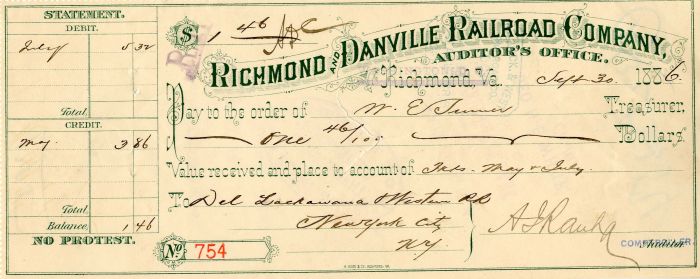Richmond and Danville Railroad Co. - Railroad Check
Inv# CKR1040 Check
Railroad Check. Richmond, Virginia. The Richmond and Danville Railroad (R&D) Company functioned as an independent railroad from 1847 until 1894, initially within the state of Virginia and subsequently expanding to encompass 3,300 miles (5,300 km) of track across nine states. Established on March 9, 1847, the railroad completed its 140-mile (230 km) route connecting Richmond and Danville by 1856. During the American Civil War, it served as a crucial transportation link between Richmond, the Confederate capital, and other regions of the Confederacy. Following the war, the railroad expanded significantly, ultimately forming the extensive 3,300-mile Richmond and Danville Railroad Company System.
In 1892, the Richmond and Danville Railroad Company entered receivership and was sold in 1894, subsequently becoming part of the newly formed Southern Railway Company (which later evolved into the Norfolk Southern Railway) in 1896 and 1897. The revitalized Richmond and Danville Railroad was promoted by Whitmell P. Tunstall, a lawyer from Chatham, Virginia, who also served in the Virginia General Assembly. Tunstall successfully obtained a charter for the new railroad on March 9, 1847. In that same year, the state of Virginia acquired a 60% stake in the company's capital stock, maintaining this interest until 1871.










Ebay ID: labarre_galleries